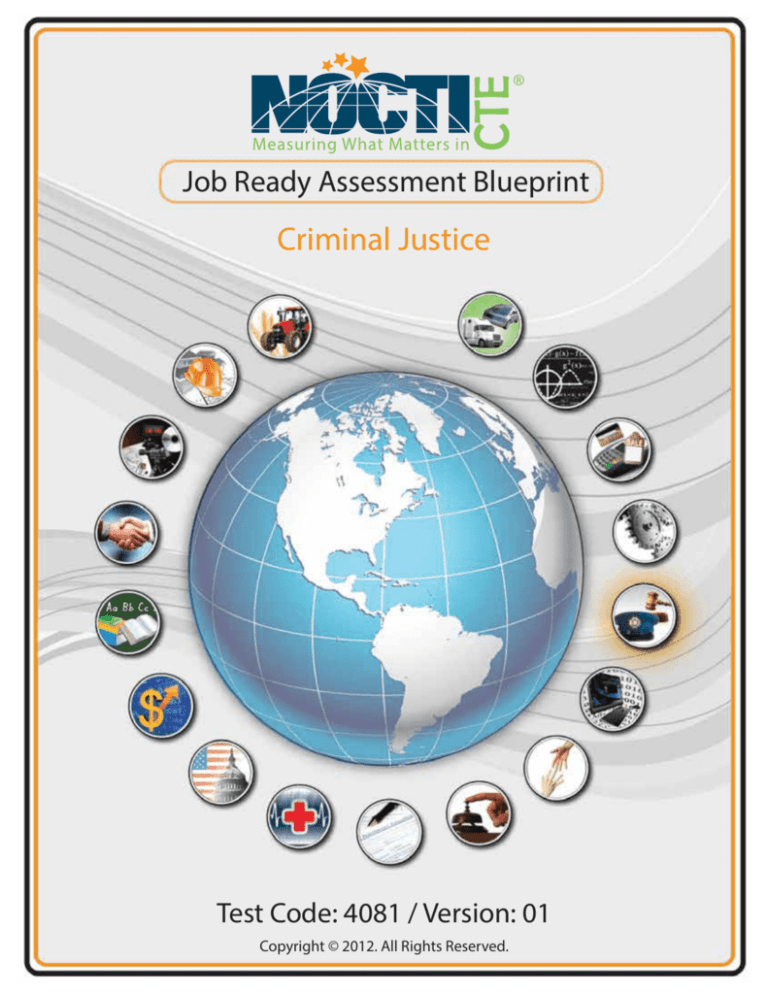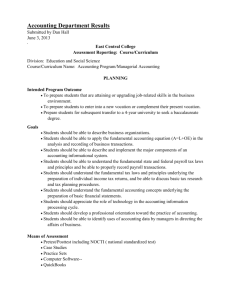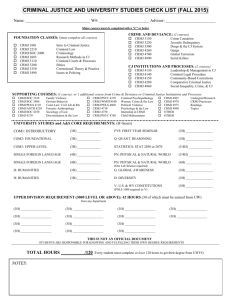
Job Ready Assessment Blueprint
Criminal Justice
Test Code: 4081 / Version: 01
Copyright © 2012. All Rights Reserved.
Criminal Justice
General Assessment Information
Blueprint Contents
General Assessment Information
Sample Written Items
Written Assessment Information
Performance Assessment Information
Specific Competencies Covered in the Test Sample Performance Job
Test Type: The Criminal Justice industry-based credential is included in NOCTI’s Job
Ready assessment battery. Job Ready assessments measure technical skills at the
occupational level and include items which gauge factual and theoretical knowledge.
Job Ready assessments typically offer both a written and performance component and
can be used at the secondary and post-secondary levels. Job Ready assessments can
be delivered in an online or paper/pencil format.
Revision Team: The assessment content is based on input from secondary,
post-secondary, and business/industry representatives from the states of Georgia,
Michigan, New Jersey, New York, and Pennsylvania.
CIP
Code
43.0107 - Criminal Justice/
Police Science
Career Cluster 12 Law, Public Safety, and Security
33-3051.01 - Police Patrol/
Police Officers
The Association for Career and Technical Education (ACTE), the leading professional
organization for career and technical educators, commends all students who
participate in career and technical education programs and choose to validate their
educational attainment through rigorous technical assessments. In taking this
assessment you demonstrate to your school, your parents and guardians, your future
employers and yourself that you understand the concepts and knowledge needed to
succeed in the workplace. Good Luck!
In the lower division
baccalaureate/associate degree
category, 3 semester hours in
Criminal Justice.
NOCTI Job Ready Assessment
Page 2 of 10
Criminal Justice
Written Assessment
NOCTI written assessments consist of questions to measure an individual’s factual
theoretical knowledge.
Administration Time: 3 hours
Number of Questions: 192
Number of Sessions: This assessment may be administered in one, two, or three sessions.
Areas Covered
Crime Scene Management
12%
9%
Use of Force
Criminal Law and Procedures
12%
7%
Health Issues
Police Concepts and Skills
19%
Corrections: Concepts and Skills
9%
Court System
11%
Communication
Security: National, International,
and Private
Understanding and Working with
Special Populations
NOCTI Job Ready Assessment
8%
9%
4%
Page 3 of 10
Criminal Justice
Specific Standards and Competencies Included in this Assessment
Crime Scene Management
• Exhibit understanding of proper evidence collection practices
• Exhibit knowledge of scientific principles involved in crime scene management
• Exhibit understanding of proper evidence preservation practices
• Exhibit understanding of initial crime scene management
• Identify and/or perform latent print techniques
• Identify and/or perform crime scene diagramming
Use of Force
• Identify acceptable levels of force
• Exhibit knowledge and understanding of civil liabilities
• Define the differences between less-than-lethal force and deadly force
• Identify non-lethal weapons and/or techniques
• Describe knowledge of basic firearm safety
Criminal Law and Procedures
• Display knowledge of search and seizure
• Identify key constitutional amendments
• Display knowledge of branches of government
• Describe arrest procedures
• Define types, categories, and/or classes of crimes
• Exhibit knowledge of differences between criminal and civil law
Health Issues
• Describe lifestyles for personal health and physical fitness for criminal justice
professionals
• Demonstrate knowledge of CPR, first aid, and emergency medical care
• Identify hazardous materials, proper response, and scene management
• Exhibit knowledge of universal precautions
(Continued on the following page)
NOCTI Job Ready Assessment
Page 4 of 10
Criminal Justice
Specific Standards and Competencies (continued)
Police Concepts and Skills
• Describe proper traffic stop techniques
• Describe proper handcuffing techniques
• Identify appropriate search procedures for persons, structures, and vehicles
• Identify different types of patrol procedures and techniques
• Describe knowledge of fingerprint processing (e.g., live scan, inked impressions,
patterns)
• Describe scene safety techniques for officer response (e.g., domestic abuse,
assault)
• Describe scene safety techniques at motor vehicle crash sites
• Describe characteristics of individuals operating a vehicle while impaired
• Identify and understand types of criminal organizations
• Display knowledge of professional ethics and conduct
• Exhibit knowledge of the history of policing
Corrections: Concepts and Skills
• Identify correction concepts, methods, and history
• Identify various types of correctional institutions
• Understand methods and history of capital punishment
• Identify prison security levels and practices
• Display knowledge of intake procedures
(Continued on the following page)
NOCTI Job Ready Assessment
Page 5 of 10
Criminal Justice
Specific Standards and Competencies (continued)
Police Concepts and Court System
• Describe types of warrants and their applications
• Display understanding of the different levels of courts
• Describe appropriate professional courtroom testimony and demeanor
• Identify occupations, roles, and responsibilities within the court system
• Exhibit knowledge of trial and court procedures
• Define court room terminology
• Exhibit knowledge of the juvenile justice system
Communication
• Display knowledge of radio usage and procedures
• Exhibit knowledge of accurate report writing and field notes
• Display knowledge of interpersonal communication techniques (e.g.,
non-verbal, verbal)
• Exhibit knowledge of effective public relations
• Display familiarity with law enforcement computer databases
Security: National, International, and Private
• Identify sources and types of domestic and international terrorism
• Exhibit knowledge of private security
• Identify different types of crime prevention techniques
• Identify methods of preventing acts of domestic and international terrorism
Understanding and Working with Special Populations
• Display understanding of cultural diversity
• Exhibit appropriate methods of interacting with persons with mental health
disabilities
NOCTI Job Ready Assessment
Page 6 of 10
Criminal Justice
Sample Questions
A firearm should always be treated as if it is
A. unloaded
B. loaded
C. safe
D. empty
When arresting a suspect known to have tuberculosis, the officer should
A. not touch the suspect
B. have the suspect wear a mask
C. wear a mask
D. take no precautions
In managing prisons and jails, one recent innovation is to operate them
A. with funds raised from traffic offenses
B. through private companies
C. under military control
D. using former inmates as guards
A _____ is a legal document ordering a person to testify in a court of law as a
witness.
A. writ of habeas corpus
B. subpoena
C. writ of tort
D. restitution
If an officer makes a stop or arrest based on a person’s race or ethnicity, it is an
example of
A. a neighborhood watch
B. community profiling
C. racial profiling
D. crime prevention
(Continued on the following page)
NOCTI Job Ready Assessment
Page 7 of 10
Criminal Justice
Sample Questions (continued)
The term, actus reus, refers to the
A. mental ability
B. guilty person
C. physical ability
D. guilty act
The most common fingerprint pattern is the
A. arch
B. whorl
C. ellipse
D. loop
A _____ is a document asking a court to assume jurisdiction over a juvenile.
A. writ
B. petition
C. request
D. subpoena
Crossing of the arms and/or legs when questioning a suspect is a probable sign of
A. nervous leg syndrome
B. questioning of a hostile witness
C. non-verbal deception
D. fight or flight syndrome
A prisoner who demonstrates suicidal tendencies should be evaluated by
A. the jail nurse
B. a mental health professional
C. the warden
D. the officer in charge
NOCTI Job Ready Assessment
Page 8 of 10
Criminal Justice
Performance Assessment
NOCTI performance assessments allow individuals to demonstrate their acquired skills by
completing actual jobs using the tools, materials, machines, and equipment related to the
technical area.
Administration Time: 2 hours and 10 minutes
Number of Jobs: 3
20%
Areas Covered:
43% Crime Scene Investigation
Participants will properly prepare, search for evidence,
measure the location of evidence, use correct photograph
techniques, correctly lift and label fingerprints, package a
wet piece of evidence, package additional evidence, read
fingerprinting, and maintain crime scene integrity.
43%
37%
37% Arrest
Participants will complete correct arrest, place handcuffs, complete a search, complete the
fingerprinting process, and complete an arrest report with correct grammar and spelling.
20% Perform CPR on an Adult
Participants will safely determine the level of consciousness, call for assistance, and perform
CPR.
NOCTI Job Ready Assessment
Page 9 of 10
Criminal Justice
Sample Job
Perform CPR on an Adult
Maximum Time: 10 minutes
Participant Activity: The participant is given a scenario. The participant must determine
scene safety and take appropriate personal protective precautions, determine the level of
consciousness, verbalize that the person is not breathing and does not have a pulse,
summon advanced help, and administer CPR for a minimum of two minutes.
NOCTI Job Ready Assessment
Page 10 of 10










